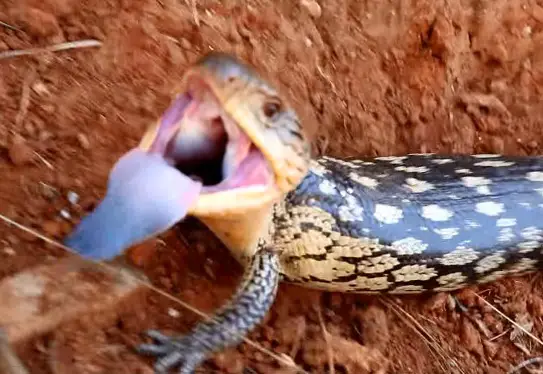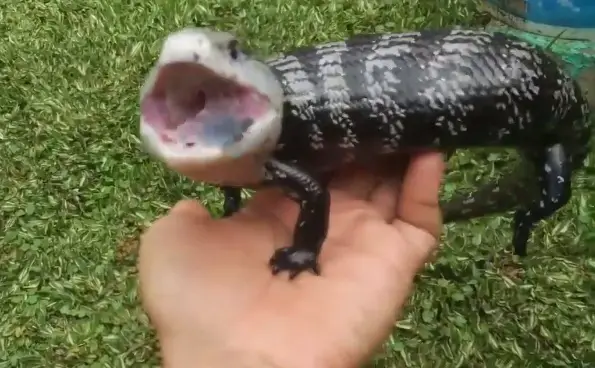Can your blue tongue skink bite? Blue tongue skinks are wild animals, and thus, it’s only natural for them to bite if they feel threatened or insecure.
Most people are afraid to handle blue tongue skinks, especially when they start to behave aggressively. If you don’t hold your blue tongue skinks regularly, they will never get used to being handled.
Thus, it is critical to handle them even when they are trying to be defensive.
In this article, we will help you to understand your blue tongue skink’s behavior, why they bite, and what to do when they bite. Also, we will help you learn how to treat a blue tongue skink bite.
Keep reading for more tips.
This article has been reviewed by Dr. Dilber. Read more about our knowledge control process here.
Contents
Does Blue Tongue Skink Bite Hurt?
Yes, a blue tongue skink bite is painful. However, blue tongue skink teeth crush rather than tear.
Blue tongue skinks are medium sized skinks having large teeth that cause rupture the skin and can cause bleeding. But pet skinks do not bite if properly trained.
Luckily, it’s elementary to tell when the blue tongue skink is going to bite. Bluetongue skink will first aggressively hiss at you, then flick out the blue tongue, and then flatten the body to look larger.
Biting is the last option when trying to scare you off. Thus, if you see any or all these defensive mechanisms signs from your pet, don’t handle it immediately.
Also, it is worth noting that some types of blue tongue skinks are more aggressive than others. Tanimbar island blue tongue skinks are known to be extremely aggressive.
Therefore, they are not the best pets, especially for families with children.
It is fun having a blue tongue skink in your home. And even though they are likely to bite at some point, it is worth having one as a pet.
To make your experience smooth and less likely to experience a blue tongue skink bite, here are some tips to help you handle them.
- Don’t handle your blue tongue skink within the first week of introducing your blue tongue skink into a new environment.
- Offer your blue tongue skink treats every time they try to attack. Treating your skink at this moment will help you quickly win its trust.
- You can read a book for your blue tongue skink during the first few weeks. This way, the blue tongue skink will recognize your voice and start being calm around you.
- Look directly into your blue tongue skinks eyes when handling her. It will make her trust you quicker.
- If your blue tongue skink is being defensive towards you, don’t hold her right away.
- Never grab your blue tongue skink. Hold it gently and make the grip firm. Grabbing your blue tongue skink will make it feel insecure and, thus, try to retaliate.
- Don’t ever handle your blue tongue skink by the tail. Blue tongue skinks tend to detach their tail as a self-defensive mechanism.
- Handle your blue tongue skink regularly until he gets used to handling. If he bites you, don’t stop handling it so that he doesn’t get used to biting you.
What do people who have been bitten by a blue tongue skink say about the bite?
According to blue tongue skink org., one breeder complained about the bite being too hard and that he thought the pet cracked his bone. However, most breeders argue about this being impossible. This is because blue tongue skink bite is usually mild and does not even break the skin in most cases.
New to blue tongue skink? Check out the blue tongue skink care sheet now! We had listed out all the things you need to know about blue tongue skinks as pets. Check it now!
In another instance, another breeder also says that his blue tongue skink bites him without warning. He says that the blue tongue skink will show the calmness and even bask next to his hand.
He says that the pet climbs on his arm, and when he least expects, he receives a bite at the same spot. Other breeders argue that the reason he bites could be because he’s just curious.
Some argue that it is because he could be wild-caught and not used to human interaction.
Whatever the cause of biting, the bite is still painful and strong. But, the bite is not so serious that it will send you to a hospital bed. If you would love to know more about what blue tongue skink breeders say about the bite, see more in this forum.
If you keenly follow these tips, you are highly likely to escape a blue tongue skink bite.
Reasons a Blue Tongue Skink Might Bite

(Source: robbiefishing YouTube)
It is worth noting that blue tongue skinks are wild animals. Therefore, if they perceive you as a threat, they naturally try to protect themselves.
The natural way of blue tongue skink or any other wild animal of protecting themselves is biting.
There are many reasons why a blue tongue skink bites.
Here, I am going to outline four significant reasons why a blue tongue skink may bite.
- Instinct
Blue tongue skinks are wild animals that act on instincts. If they feel threatened, their instincts tell them to protect themselves.
When wild animals are scared or perceive you as a threat, they have a response called “fight or flight.” They produce hormones that prepare them to run or stay and fight.
Thus, if your blue tongue skink sees you as a threat, it will either try to hide or try to bite you.
Untamed blue tongue skinks are more highly to bite on instincts. Thus, it is critical to tame your blue tongue skink before handling them.
Also, it is wise to get your blue tongue skink from a domestic breeder. It is because pets from local breeders are used to human interactions and thus easy to tame.
On the other hand, blue tongue skinks from the wild are not used to being handled, and thus, it might be impossible to tame them.
- Wrong handling
If you don’t handle your blue tongue skink in the right way, it might get uncomfortable and thus retaliate:
- Handling a frightened blue tongue skink
- Handling a new skink
- Handling while eating
- Touching any injured site on skin
- Picking skink from tail.
It is, therefore, essential to know how to handle it right before handling it.
The best way to handle it is by making sure that you use both your hands. Support both his fore and hind legs, while his tail rests on your arm. Also, make sure that the hold is firm, but don’t press him too hard.
If your blue tongue skink tries to be defensive, don’t show him that you are scared. At first, you can wear welding gloves to avoid the bite. And, if your pet bites your gloves, don’t put him down immediately. The sudden drop will make him more scared and thus more defensive.
If you suddenly drop him anytime he tries to bite you; he will get accustomed to biting you so you can leave him alone.
You can also try to look into his eyes when holding him directly. This way, you will be able to win his trust easily.
- If he’s hungry
If you haven’t fed your blue tongue skink for days, don’t try to hold him before feeding him. He might mistake your fingers for pinky mice. Hungry blue tongue skink is highly likely to act aggressively.
Therefore, before handling your blue tongue skink, it would be best if you feed him first.
- Untamed blue tongue skink
If you just bought your blue tongue skink, it is highly likely to be defensive. This is because blue tongue skinks get stressed in a new environment. Thus, the best thing to do would be not to handle it for at least two weeks.
Within the first two weeks after introducing a blue tongue skink in a new environment, they spend most of their time hiding. During this time, they will hiss, stick out their tongue, and try to bite you if you decide to handle them.
Therefore, you should be patient with them until they start getting used to you. Frequently speaking to your blue tongue skinks and giving them treats will help you win their trust quickly.
The best way to avoid a blue tongue skink bite is to be a little cautious and understand their body language. If you see your blue tongue skink hissing, puffing, and sticking out the tongue, it is warning you.
Thus, don’t handle him immediately as it is highly likely to bite.
New to blue tongue skink? Check out the blue tongue skink care sheet now! We had listed out all the things you need to know about blue tongue skinks as pets. Check it now!
Is A Bite From A Blue Tongue Skink Dangerous?

(Source: Pananesia YouTube)
Blue tongue skink bite is not poisonous. However, blue tongue skinks have an impressive jaw strength that makes the bite very painful. Even so, they do not have well-developed teeth, but they don’t easily let go once they bite. Therefore, latching makes the bite even more painful.
Vet answer: The saliva of blue tongue skink is not poisonous and have no toxins. So, it is not dangerous. However, you should wash the wound with an antiseptic to prevent the secondary infection.
Bluetongue skinks have stumpy legs, and thus, they cannot sprint. For this reason, their scare tactics are to hiss, flick out their tongue, or bite you.
Blue tongue skinks will give you signs before biting. Therefore, it is not too hard to escape a bite from the pet. If you are not too lucky and get a bite, don’t overreact as the bite is not dangerous.
In most cases, the bite will not even break your skink as they only have tiny, undeveloped teeth. When a blue tongue skink bites, they tend not to let go quickly. However, if the bite is painful, don’t try to fight back.
Fighting back will only frighten the blue tongue skink more, and thus, he will try to bite you again the next time you handle it. Therefore, the best thing to do when a blue tongue skink bites is to stay calm.
This way, the blue tongue skink eventually lets go of your skin and moves away.
Even though blue tongue skinks are non-venomous, if they bite, the wound could result in other bacterial infections. Thus, it is critical to treat the injury seriously.
The best way to treat the wound would be by thoroughly cleaning and disinfecting it. Also, you should make sure that your tetanus shot is up to date to prevent more infections. If necessary, you should take oral antibiotics to prevent bacterial infections on the wound.
Blue tongue skinks could contain Salmonella sp. Bacteria. Some of the symptoms of Salmonella sp. bacteria include; diarrhea, vomiting, fever, nausea, and stomach ache. If you present some or all of these symptoms, you should immediately consult a physician.
Another kind of infection that blue tongue skinks can transmit to humans is Rickettsial disease. In most cases, blue tongue skinks contract this infection through mites.
In humans, symptoms include; headache, fever, widespread rashes, or generally feeling unwell. Therefore, thoroughly wash and disinfect your hands after handling your blue tongue skink.
How To Treat A Blue Tongue Skink Bite?
When blue tongue skink bites stay calm and let the animal let go, and don’t try to force it.
Once it lets go, you can slowly put him down and immediately wash your hands with soap. Use an alcohol swab to clean the bitten area and then apply a Band-Aid.
Vet answer: If a blue tongue skink bites, first of all wash the site, apply the antiseptic and cover it with a bandage or cloth. This is best way to prevent secondary infections and start healing process immediately.
If there is a lot of pain, or the injury seems dangerous, consult your doctor immediately.
Remember that blue tongue skinks are not like dogs or cats that you can completely tame. Therefore, they are much more likely to bite you again and again. Some blue tongue skink keepers say that they have been bitten by their pet more than once.
Some even say that their blue tongue skink didn’t show the defensive characteristics before biting them. However, the good news is that most of them didn’t get serious bites.
Therefore, if you are a blue tongue skink enthusiast, you just have to be patient with your pet. Eventually, you will be able to bond and handle him without those unpleasant moments of biting.
Wrapping Up
Blue tongue skinks are curious animals. Sometimes they bite you because they mistake you for food. Also, it could be because they have never been handled or had a bad experience with human interactions.
Therefore, the best way to bond with them is to be patient and understand their body language. To make them trust you, or rather see you as the person who feeds them, you can pop in her favorite food every time she opens her mouth to bite.
This way, your blue tongue skink can start to see you as their food giver and not a threat. If this doesn’t work, you will have to try other taming methods until you know what works for her.
All in all, blue tongue skinks make great pets. Therefore, a little patience and taming, and soon you will be a proud owner of a blue tongue skink pet.
All the best with your pet!
